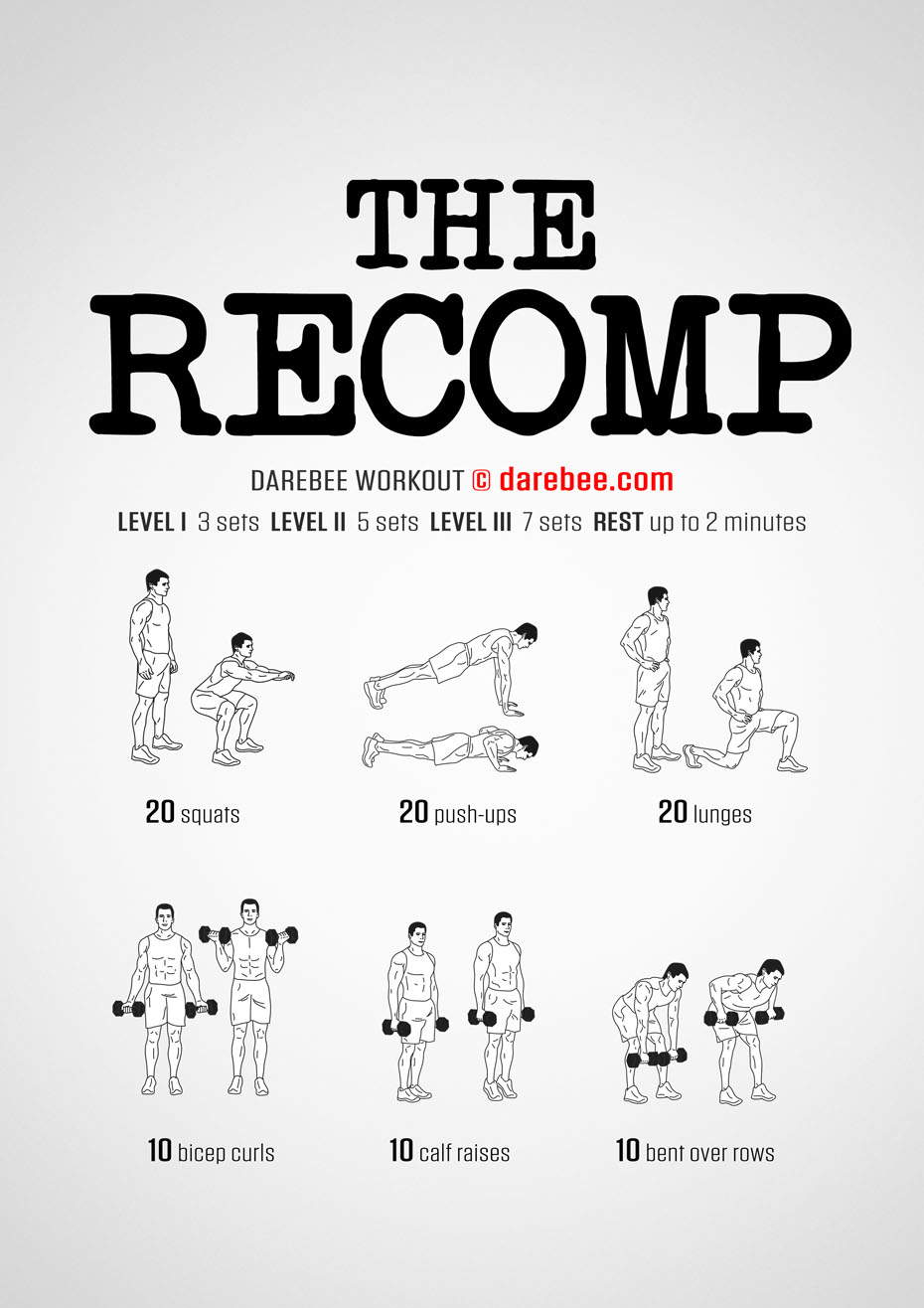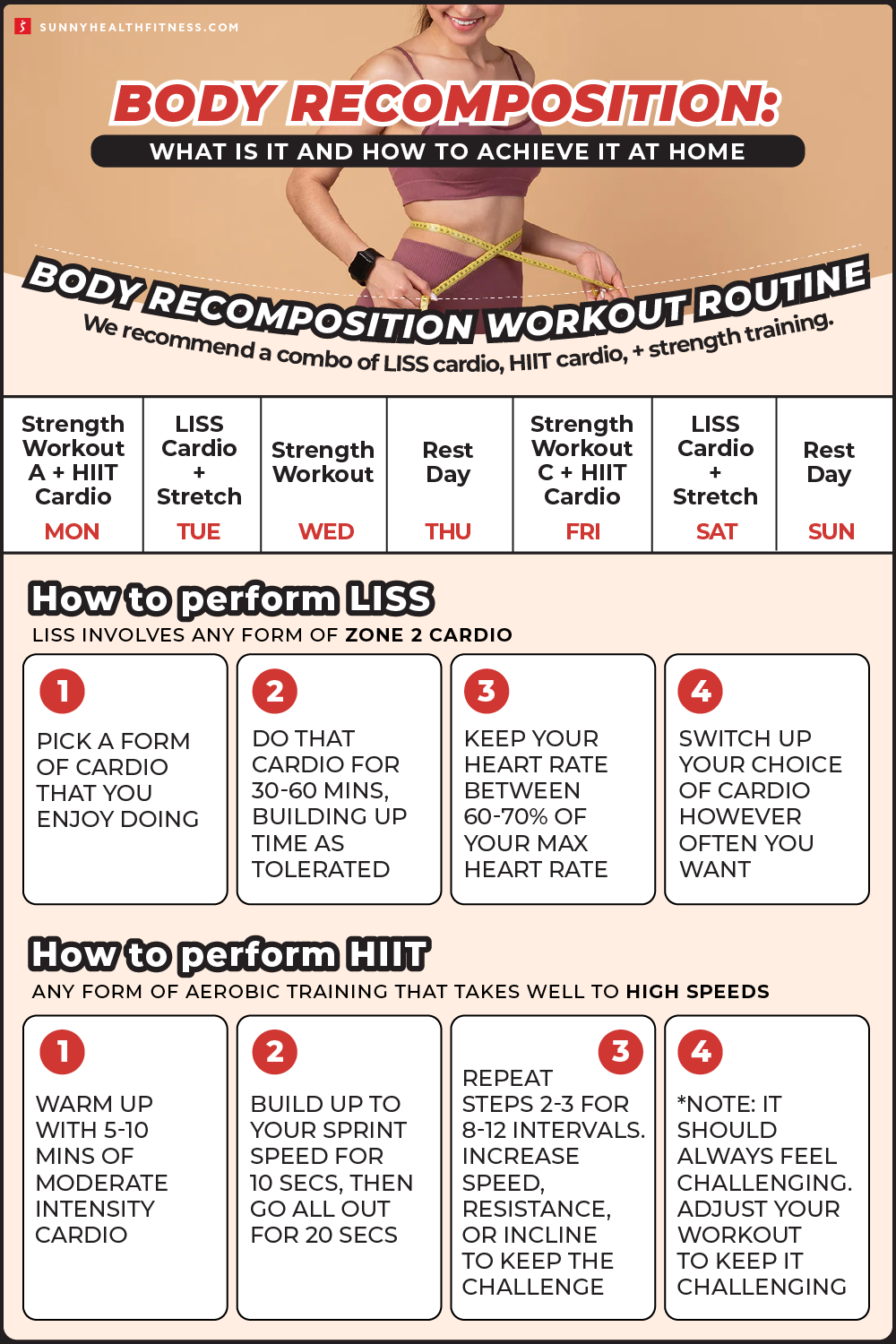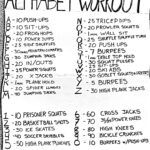Transforming your body doesn’t require a gym membership. A home workout can achieve body recomposition effectively.
Body recomposition focuses on shedding fat and building muscle simultaneously. This approach helps you achieve a lean, strong physique without drastic dieting. The key lies in balancing nutrition and exercise. You can create an effective workout routine right in your living room.
No fancy equipment needed! It’s about smart planning and consistency. With dedication and proper guidance, you can see real changes over time. This workout plan will guide you through exercises that target different muscle groups. It ensures you get a full-body workout while burning calories. Ready to transform your body at home? Let’s dive into how you can start your body recomposition journey today.
Introduction To Body Recomposition
Body recomposition is an exciting fitness journey. It focuses on gaining muscle while losing fat. Many people find this approach effective. It changes your body’s composition, not just the weight on the scale.
What Is Body Recomposition?
Body recomposition is about balance. It isn’t just weight loss. The goal is to increase muscle mass and decrease fat. This approach benefits overall health and appearance. Many fitness enthusiasts choose this method. It focuses on long-term results.
Benefits Of Recomposition
Body recomposition offers many advantages. First, it improves muscle strength. Strong muscles support daily activities. Second, it enhances fat loss. Less fat means a healthier body. Third, it boosts metabolism. A faster metabolism burns calories efficiently. These benefits contribute to a better lifestyle.
Setting Realistic Goals
Crafting a home workout plan for body recomposition requires setting realistic goals. Focus on achievable targets to build muscle and reduce fat effectively. Consistency and discipline are key to seeing progress over time.
Setting realistic goals is a crucial step in any body recomposition workout plan at home. It’s easy to get swept away by the excitement of transformation, but having clear, achievable targets keeps you grounded. Knowing what you want to achieve and how to get there will make your fitness journey both rewarding and sustainable.Identifying Personal Objectives
Start by understanding what you want from your body recomposition journey. Do you want to lose fat, gain muscle, or both? Clarifying these objectives can help tailor your workout plan to your specific needs. Consider your current fitness level and lifestyle. If you’re juggling work, family, and other commitments, setting a goal to workout two hours daily might be unrealistic. Instead, aim for a consistent, manageable routine that fits your schedule. Think about what motivates you. Is it fitting into your favorite jeans, improving your stamina, or simply feeling healthier? Use this motivation to define your objectives and keep you inspired.Tracking Progress And Adjustments
Monitoring your progress is essential to achieving your goals. Use tools like a fitness journal or a mobile app to record your workouts and track changes in your body composition. Regularly assess your progress. Are you moving closer to your goals, or have you hit a plateau? This evaluation is crucial for making necessary adjustments to your workout plan. Don’t be afraid to tweak your routine. If a particular exercise isn’t giving you results, switch it up. Flexibility in your approach ensures you stay on track, even when challenges arise. Setting realistic goals is about aligning your aspirations with practical steps. What small change can you make today to get closer to your objective?Essential Home Equipment
Creating an effective body recomposition workout plan at home requires essential equipment. These tools help you build strength and lose fat efficiently. With the right equipment, you can achieve your fitness goals without needing a gym membership.
Budget-friendly Tools
Investing in budget-friendly tools is key for a home workout. Resistance bands offer versatility for strength training. They are affordable and take up little space. Dumbbells are another great option. Choose adjustable dumbbells for varied weight options. A yoga mat provides comfort for floor exercises and stretches. Jump ropes boost cardio fitness and are inexpensive. These tools are cost-effective and efficient.
Maximizing Space And Efficiency
Small spaces need smart solutions for workouts. Choose equipment that folds or stacks neatly. A foldable exercise bench fits in tight spaces. Wall-mounted pull-up bars save floor space. Doorway resistance bands utilize unused spaces. Keep your equipment organized with storage racks. Efficient use of space enhances your workout experience at home.

Credit: darebee.com
Designing A Balanced Workout
Designing a balanced workout plan at home is crucial for achieving body recomposition. It involves strategic exercise choices that support both fat loss and muscle gain. This means finding harmony between cardio and strength training, and creating a weekly schedule that fits your lifestyle. You don’t need fancy equipment or a gym membership to make it happen. With a bit of creativity and dedication, you can transform your living space into your personal fitness haven.
Combining Cardio And Strength
Cardio workouts are essential for burning calories and improving cardiovascular health. But relying solely on cardio can lead to muscle loss. Strength training helps build and maintain muscle mass, which is vital for body recomposition. Combining both types of workouts in your routine ensures you burn fat while preserving or gaining muscle.
Imagine a workout where you start with a brisk walk or jog around your neighborhood to elevate your heart rate. Follow this with strength exercises using body weight or simple tools like resistance bands or dumbbells. This combination not only boosts your metabolism but also keeps your workout engaging.
Reflect on your goals. Do you want to shed fat, build muscle, or both? Tailor your workouts to match your objectives. If you’re unsure, experiment with different exercises to find what excites you. This approach will keep you motivated and committed.
Weekly Workout Schedule
A well-structured weekly workout schedule helps you stay consistent and track progress. Start by allocating specific days for cardio and others for strength training. This balance prevents burnout and allows muscles to recover.
Here’s a simple schedule to get you started:
| Day | Workout Type |
|---|---|
| Monday | Cardio (30 minutes) |
| Tuesday | Strength (Focus on upper body) |
| Wednesday | Rest or light stretching |
| Thursday | Cardio (Intervals or dance) |
| Friday | Strength (Focus on lower body) |
| Saturday | Active recovery (yoga or walking) |
| Sunday | Rest |
Each workout day should be tailored to your energy levels and goals. Are you feeling energetic? Try a high-intensity interval training session on cardio days. Feeling sluggish? Opt for a gentle walk or light yoga.
Don’t forget to listen to your body. Adjust the schedule as needed. The goal is to make workouts sustainable and enjoyable. What works for someone else might not work for you. The key is finding a rhythm that suits your lifestyle.
Consider logging your workouts and progress. Seeing improvements can be incredibly motivating. Do you notice your stamina increasing or your clothes fitting better? Celebrate these victories. They are proof that you’re on the right track.
Strength Training At Home
Creating a body recomposition workout plan at home is easier than you think. Strength training is a crucial part of this plan. It helps build muscle and burn fat. Working out at home can be convenient and effective. No need for expensive gym memberships or equipment. You can use your body weight or simple tools. Let’s explore two key methods: bodyweight exercises and resistance band workouts.
Bodyweight Exercises
Bodyweight exercises use your weight to build strength. They can be done anywhere. Common exercises include push-ups, squats, and lunges. These moves target major muscle groups. They increase muscle mass and tone. For push-ups, start on your knees if needed. Gradually progress to full push-ups. Squats work your legs and glutes. Keep your back straight and lower your body. Lunges improve balance and leg strength. Step forward, bend your knees, and keep your torso upright.
Consistency is key with bodyweight exercises. Aim for three sessions per week. Mix up your routine to keep it exciting. Add new moves or increase repetitions over time. This helps avoid plateaus and keeps your muscles challenged.
Resistance Band Workouts
Resistance bands are versatile and affordable. They provide varying levels of resistance. This makes them great for all fitness levels. Use bands for exercises like bicep curls and chest presses. Bicep curls target the front of your arms. Stand on the band, hold the handles, and curl your arms. Chest presses work the chest and shoulders. Anchor the band behind you and push forward.
Resistance bands also enhance bodyweight exercises. Add them to squats or lunges for extra challenge. They are lightweight and easy to store. This makes them perfect for home use. Incorporating resistance bands can boost your strength gains.
Both bodyweight exercises and resistance bands offer effective home workouts. They build strength and support body recomposition goals. Regular practice leads to visible results. Start today and see the transformation in your strength and physique.
Cardio Routines Without Equipment
Transform your body with cardio routines that require no equipment. Boost your fitness with exercises like jumping jacks and burpees. Perfect for a home body recomposition workout plan. Stay fit without the gym. Easy moves for everyone.
Cardio routines without equipment offer flexibility and convenience. You can perform them at home, saving time and money. These workouts boost heart health and burn calories. They require no gym or fancy gear. Just your body and some space.High-intensity Interval Training
High-Intensity Interval Training (HIIT) involves short bursts of intense exercise. Followed by brief rest periods. This method maximizes fat burning in minimal time. Exercises like burpees and jumping jacks work well. Alternate between high intensity and rest for 20 minutes. It improves stamina and cardiovascular health.Low-impact Alternatives
Low-impact cardio is gentle on joints. Ideal for beginners or those with injuries. Exercises like marching in place and step touches are effective. They raise heart rate without straining the body. Low-impact routines can be done daily. They enhance endurance while keeping you safe from injury.Nutrition For Recomposition
Achieve body recomposition at home with a balanced workout plan. Combine strength training with nutritious meals for optimal results. Focus on protein-rich foods to support muscle growth and fat loss.
Achieving body recomposition at home is an exciting journey. But it demands more than just working out. Nutrition plays a crucial role in this transformation. The right food choices can fuel your workouts and promote muscle growth while burning fat. How can you ensure your diet supports your goals? Let’s dive into the essentials of nutrition for recomposition.Macronutrient Essentials
Your body needs the right balance of macronutrients—proteins, carbohydrates, and fats—to thrive. Protein is your muscle’s best friend. Aim for lean sources like chicken, fish, or plant-based options such as beans and lentils. Carbohydrates provide the energy you need to power through those home workouts. Opt for complex carbs like whole grains and sweet potatoes. Healthy fats, found in foods like avocados and nuts, support hormone production and overall health. But how much of each should you consume? A common strategy is to ensure each meal contains a balance of these macronutrients. A helpful guideline is aiming for about 40% carbs, 30% protein, and 30% fats. Adjust this based on your personal needs and activity levels.Meal Planning Tips
Meal planning can be a game-changer for sticking to your nutrition goals. Start by creating a weekly menu that includes a variety of foods. This helps prevent boredom and ensures you get a wide range of nutrients. Prepping meals in advance can save time and reduce the temptation of unhealthy snacks. Think about portion sizes. Using a scale or measuring cups can help you stay on track without overeating. Also, keep healthy snacks like fruits, nuts, or yogurt on hand. This makes it easier to avoid sugary or processed options when hunger strikes. Consistency is key. It’s not about following a strict diet but rather making sustainable changes. Have you ever noticed how small changes can lead to big results? Keep a food journal to track your progress and stay accountable. By focusing on these nutritional strategies, you’re setting yourself up for success in your body recomposition journey. What changes will you make to your diet today to get closer to your goals?
Credit: www.pinterest.com
Staying Motivated And Consistent
Stay motivated with a home workout plan for body recomposition. Small, consistent steps lead to big changes. Build a routine that fits your lifestyle, and watch your body transform over time.
Staying motivated and consistent with your body recomposition workout plan at home can be challenging. Life gets busy, and it’s easy to let your fitness goals slide. However, with the right mindset and strategies, you can stay on track and see the results you want.Overcoming Plateaus
Plateaus happen to everyone, and they can be frustrating. When you stop seeing progress, it’s important not to give up. Mix up your routine by trying new exercises or increasing the intensity of your workouts. Set small, achievable goals to keep yourself motivated. Celebrate these wins, no matter how small they seem. This keeps the momentum going and reminds you of how far you’ve come. Ask yourself: what is one thing I can change today to push past this plateau?Building A Support System
A strong support system can make all the difference in staying motivated. Share your goals with friends or family members who encourage you. They can provide accountability and cheer you on when you need it most. Consider joining online fitness communities where you can exchange tips and experiences. These platforms can offer new ideas and a sense of camaraderie. Have you thought about who could be your workout buddy or accountability partner? Having someone by your side can make the journey more enjoyable and less daunting. Remember, staying motivated and consistent is about finding what works for you and sticking with it. Make adjustments as needed and stay committed to your goals.Tracking And Adjusting Your Plan
Staying on track with your body recomposition workout plan at home is crucial. Monitoring progress helps you make timely adjustments. This ensures your workouts remain effective and aligned with your goals. Tracking your plan lets you see what works and what doesn’t. Adjustments can be made based on this data. It’s essential for achieving desired results. Let’s explore how to track and adjust your workout plan using various tools and methods.
Using Apps And Tools
Fitness apps offer a convenient way to track progress. Many apps provide features to log workouts and nutrition. They help you monitor your daily activities. Apps can display trends over time. You can see improvements or areas needing focus. Some tools allow you to set goals. They remind you to stay on track. Using apps simplifies tracking, making it less overwhelming.
Understanding Body Signals
Your body communicates through signals. Listening to these helps in adjusting your plan. Feeling overly tired may indicate overtraining. Lack of energy can suggest nutritional gaps. Noticing changes in mood or sleep patterns is important. They can be signs of imbalance. Adjusting your plan based on body signals enhances its effectiveness. It ensures you remain healthy and motivated.

Credit: sunnyhealthfitness.com
Conclusion And Next Steps
Explore effective exercises for body recomposition at home. Focus on consistency and proper form to see results. Gradually increase intensity to challenge your muscles and enhance progress.
Embarking on a body recomposition workout plan at home is a journey filled with challenges and victories. You’ve put in the effort, learned new things, and pushed your limits. Now, let’s look forward and consider what’s next. Reflecting on your journey and setting future goals are crucial steps in keeping the momentum going and ensuring continued success.Reflecting On Your Journey
Take a moment to think about your progress. What were your biggest achievements? Maybe you noticed significant changes in your strength or endurance. Celebrate these wins, no matter how small they seem. Reflect on the obstacles you faced. Did you struggle with consistency or motivation? Understanding these challenges can help you grow. Use this insight to adapt your routine for better results. Consider the impact this journey has had on your daily life. Have you felt more energetic or confident? Recognizing these benefits can inspire you to keep going.Setting Future Goals
Now, it’s time to set new goals. Aim for specific, achievable targets. Maybe you want to increase your workout frequency or try new exercises. Clear goals keep you focused and driven. Think about the skills you want to develop. Is there a particular exercise you want to master? Break it down into manageable steps and work towards it. Consider how you will track your progress. Will you keep a journal or use an app? Monitoring your journey helps you stay accountable and motivated. — Your journey doesn’t end here. What do you envision for your fitness future? Engaging with these questions can provide clarity and direction. Keep pushing forward, and remember, every step counts.Frequently Asked Questions
Is It Possible To Do Body Recomposition At Home?
Yes, body recomposition is achievable at home. Focus on strength training, balanced nutrition, and regular exercise. Use resistance bands, dumbbells, and bodyweight exercises. Track your progress to stay motivated. Stay consistent with your routine and adapt as needed for optimal results.
What Is The Best Workout Plan For Body Recomposition?
The best workout plan for body recomposition combines strength training and cardio. Focus on compound exercises like squats and deadlifts. Include high-intensity interval training (HIIT) for effective fat loss. Maintain a balanced diet with adequate protein to support muscle growth and recovery.
Consistency is key for achieving desired results.
How Long Does It Take To Recomposition A Body?
Body recomposition typically takes several months. Progress depends on consistency, diet, exercise, and individual factors. Stay patient and committed for best results.
How Many Days A Week Should I Workout For Body Recomposition?
Aim for 3-5 workout days weekly for effective body recomposition. Balance strength training and cardio sessions. Adjust based on individual goals and recovery needs. Consistency and proper nutrition also play crucial roles in achieving desired results. Listen to your body and make necessary adjustments for optimal progress.
Conclusion
A home workout plan can reshape your body effectively. Consistency is the key. Focus on balanced exercises for overall fitness. Mix strength and cardio for best results. Track progress to stay motivated. Listen to your body and rest when needed.
Adjust workouts as you improve. Healthy eating complements exercise and boosts results. Remember to stay hydrated and get enough sleep. Celebrate small victories and keep pushing forward. Achieving body recomposition requires patience and dedication. Your journey to a healthier you starts today.
Keep moving, stay positive, and enjoy the process.





